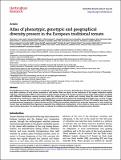Por favor, use este identificador para citar o enlazar a este item:
http://hdl.handle.net/10261/304687COMPARTIR / EXPORTAR:
 SHARE SHARE
 CORE
BASE CORE
BASE
|
|
| Visualizar otros formatos: MARC | Dublin Core | RDF | ORE | MODS | METS | DIDL | DATACITE | |

| Título: | Atlas of phenotypic, genotypic and geographical diversity present in the European traditional tomato |
Autor: | Pons, Clara CSIC ORCID; Casals, Joan; Palombieri, Samuela; Fontanet, Lilian; Riccini, Alessandro; Rambla, José Luis CSIC ORCID; Ruggiero, Alessandra; Figás, Maria Del Rosario; Plazas, Mariola; Koukounaras, Athanasios; Picarella, Maurizio E; Sulli, Maria; Fisher, Josef; Ziarsolo, Peio; Blanca, Jose; Cañizares, Joaquin; Cammareri, Maria; Vitiello, Antonella; Batelli, Giorgia; Kanellis, Angelos; Brouwer, Matthijs; Finkers, Richard; Nikoloudis, Konstantinos; Soler, Salvador; Giuliano, Giovanni; Grillo, Stephania; Grandillo, Silvana; Zamir, Dani; Mazzucato, Andrea; Causse, Mathilde; Díez, Maria José; Prohens, Jaime; Monforte, Antonio Jose; Granell, Antonio CSIC ORCID | Fecha de publicación: | 2022 | Resumen: | The Mediterranean basin countries are considered secondary centres of tomato diversification. However, information on phenotypic and allelic variation of local tomato materials is still limited. Here we report on the evaluation of the largest traditional tomato collection, which includes 1499 accessions from Southern Europe. Analyses of 70 traits revealed a broad range of phenotypic variability with different distributions among countries, with the culinary end use within each country being the main driver of tomato diversification. Furthermore, eight main tomato types (phenoclusters) were defined by integrating phenotypic data, country of origin, and end use. Genome-wide association study (GWAS) meta-analyses identified associations in 211 loci, 159 of which were novel. The multidimensional integration of phenoclusters and the GWAS meta-analysis identified the molecular signatures for each traditional tomato type and indicated that signatures originated from differential combinations of loci, which in some cases converged in the same tomato phenotype. Our results provide a roadmap for studying and exploiting this untapped tomato diversity. | URI: | http://hdl.handle.net/10261/304687 | DOI: | 10.1093/hr/uhac112 | ISSN: | 2662-6810 |
| Aparece en las colecciones: | (IBMCP) Artículos |
Ficheros en este ítem:
| Fichero | Descripción | Tamaño | Formato | |
|---|---|---|---|---|
| uhac112.pdf | 4,34 MB | Adobe PDF |  Visualizar/Abrir |
CORE Recommender
PubMed Central
Citations
6
checked on 15-abr-2024
SCOPUSTM
Citations
11
checked on 21-abr-2024
WEB OF SCIENCETM
Citations
9
checked on 22-feb-2024
Page view(s)
27
checked on 28-abr-2024
Download(s)
20
checked on 28-abr-2024
Google ScholarTM
Check
Altmetric
Altmetric
Artículos relacionados:
NOTA: Los ítems de Digital.CSIC están protegidos por copyright, con todos los derechos reservados, a menos que se indique lo contrario.
